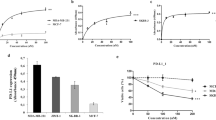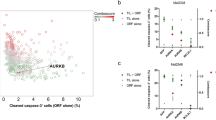Abstract
The activation of signal transducer and activator of transcription 3 (STAT3) has been identified as a key mediator that drives the fundamental components of melanoma malignancy, including immune suppression in melanoma patients. Increasing evidence also suggests that regulatory T cells (Tregs) are important in suppressing anti-tumor immunity and play a dominant role in negating efficacious immunotherapy approaches. We hypothesized that WP1066, a novel inhibitor of STAT3 signaling, reverses immune suppression through the inhibition of Tregs and that this contributes to the antitumor activity of this agent against melanoma brain metastases. We found that the mean percentage of peripheral blood mononuclear cells expressing phosphorylated STAT3 (p-STAT3) was significantly elevated in samples from patients with melanoma brain metastases compared to healthy donors, 16.13 ± 2.48% versus 4.17 ± 1.79%. The p-STAT3 inhibitor WP1066 enhanced CD3+ (which contained Tregs) but not CD8+ T cell cytotoxicity against human A375 melanoma cells, indicating that this p-STAT3 blockade agent did not directly activate CD8+ T cells. Furthermore, the p-STAT3 inhibitor did not enhance the cytotoxicity of CD3+CD25− T cells (from which Tregs were excluded), indicating that the enhanced cytotoxicity of WP1066 is secondary to its inhibition of Tregs. This was confirmed by demonstrating that WP1066 inhibited FoxP3+ Treg induction in a dose-dependent manner. Moreover, CD3+ T cells exhibited markedly enhanced levels of phosphorylated ZAP-70, a critical proximal signal in T cell activation, after exposure to WP1066. Similar effects were not observed in Treg-depleted CD3+CD25− T cell populations, confirming that the T cell activation by WP compounds is secondary to their inhibition of the Tregs. These results suggest that WP1066 enhances T cell cytotoxicity against melanoma through inhibition of Tregs.






Similar content being viewed by others
References
Ahmad M, Rees RC, Ali SA (2004) Escape from immunotherapy: possible mechanisms that influence tumor regression/progression. Cancer Immunol Immunother 53:844–854
Atkins MB, Kunkel L, Sznol M, Rosenberg SA (2000) High-dose recombinant interleukin-2 therapy in patients with metastatic melanoma: long-term survival update. Cancer J Sci Am 6(Suppl 1):S11–S14
Atkins MB, Lotze MT, Dutcher JP, Fisher RI, Weiss G, Margolin K, Abrams J, Sznol M, Parkinson D, Hawkins M, Paradise C, Kunkel L, Rosenberg SA (1999) High-dose recombinant interleukin 2 therapy for patients with metastatic melanoma: analysis of 270 patients treated between 1985 and 1993. J Clin Oncol 17:2105–2116
Chattopadhyay S, Chakraborty NG, Mukherji B (2005) Regulatory T cells and tumor immunity. Cancer Immunol Immunother 54:1153–1161
Darnell JE Jr (2002) Transcription factors as targets for cancer therapy. Nat Rev Cancer 2:740–749
Fecci PE, Mitchell DA, Whitesides JF, Xie W, Friedman AH, Archer GE, Herndon JE 2nd, Bigner DD, Dranoff G, Sampson JH (2006a) Increased regulatory T-cell fraction amidst a diminished CD4 compartment explains cellular immune defects in patients with malignant glioma. Cancer Res 66:3294–3302
Fecci PE, Ochiai H, Mitchell DA, Grossi PM, Sweeney AE, Archer GE, Cummings T, Allison JP, Bigner DD, Sampson JH (2007) Systemic CTLA-4 blockade ameliorates glioma-induced changes to the CD4+ T cell compartment without affecting regulatory T-cell function. Clin Cancer Res 13:2158–2167
Fecci PE, Sweeney AE, Grossi PM, Nair SK, Learn CA, Mitchell DA, Cui X, Cummings TJ, Bigner DD, Gilboa E, Sampson JH (2006b) Systemic anti-CD25 monoclonal antibody administration safely enhances immunity in murine glioma without eliminating regulatory T cells. Clin Cancer Res 12:4294–4305
Gijbels K, Van Damme J, Proost P, Put W, Carton H, Billiau A (1990) Interleukin 6 production in the central nervous system during experimental autoimmune encephalomyelitis. Eur J Immunol 20:233–235
Heimberger AB, Crotty LE, Archer GE, Hess KR, Wikstrand CJ, Friedman AH, Friedman HS, Bigner DD, Sampson JH (2003) Epidermal growth factor receptor VIII peptide vaccination is efficacious against established intracerebral tumors. Clin Cancer Res 9:4247–4254
Heimberger AB, Priebe W, Fokt I, Szymanski S, Hussain SF, Kong L-Y (2007) Small molecule inhibitors for immune modulation. US 0/908, 559
Heinrich PC, Behrmann I, Haan S, Hermanns HM, Muller-Newen G, Schaper F (2003) Principles of interleukin (IL)-6-type cytokine signalling and its regulation. Biochem J 374:1–20
Hussain SF, Kong L-Y, Jordan J, Conrad C, Madden T, Fokt I, Priebe W, Heimberger AB (2007) A novel small molecule inhibitor of signal transducers and activators of transcription 3 reverses immune tolerance in malignant glioma patients. Cancer Res 67:9630–9636
Kinjyo I, Inoue H, Hamano S, Fukuyama S, Yoshimura T, Koga K, Takaki H, Himeno K, Takaesu G, Kobayashi T, Yoshimura A (2006) Loss of SOCS3 in T helper cells resulted in reduced immune responses and hyperproduction of interleukin 10 and transforming growth factor-beta 1. J Exp Med 203:1021–1031
Kong LY, Abou-Ghazal MK, Wei J, Chakraborty A, Sun W, Qiao W, Fuller GN, Fokt I, Grimm EA, Schmittling RJ, Archer GE Jr, Sampson JH, Priebe W, Heimberger AB (2008) A novel inhibitor of STAT3 activation is efficacious against established central nervous system melanoma and inhibits regulatory T cells. Clin Cancer Res 14:5759–5768
Kortylewski M, Jove R, Yu H (2005) Targeting STAT3 affects melanoma on multiple fronts. Cancer Metastasis Rev 24:315–327
Kortylewski M, Kujawski M, Wang T, Wei S, Zhang S, Pilon-Thomas S, Niu G, Kay H, Mule J, Kerr WG, Jove R, Pardoll D, Yu H (2005) Inhibiting Stat3 signaling in the hematopoietic system elicits multicomponent antitumor immunity. Nat Med 11:1314–1321
Kurdi M, Booz GW (2007) Can the protective actions of JAK-STAT in the heart be exploited therapeutically? Parsing the regulation of interleukin-6-type cytokine signaling. J Cardiovasc Pharmacol 50:126–141
Lau LT, Yu AC (2001) Astrocytes produce and release interleukin-1, interleukin-6, tumor necrosis factor alpha and interferon-gamma following traumatic and metabolic injury. J Neurotrauma 18:351–359
Li B, Chang CM, Yuan M, McKenna WG, Shu HK (2003) Resistance to small molecule inhibitors of epidermal growth factor receptor in malignant gliomas. Cancer Res 63:7443–7450
Madden T, Kazerooni R, Myer J, Culotta K, Donato N, Johansen M, Kondo Y, Mack D, Priebe W (2006) The preclinical pharmacology of WP1066, a potent small molecule inhibitor of the JAK2/STAT3 pathway. In: Proceedings of the 97th American Association for Cancer Research Annual Meeting. Washington, DC
Niu G, Bowman T, Huang M, Shivers S, Reintgen D, Daud A, Chang A, Kraker A, Jove R, Yu H (2002) Roles of activated Src and Stat3 signaling in melanoma tumor cell growth. Oncogene 21:7001–7010
Prendergast GC (2008) Immune escape as a fundamental trait of cancer: focus on IDO. Oncogene 27:3889–3900
Priebe W, Donato N, Talpaz M, Fokt I, Szymanski S (2004) Novel compounds for treatment of cell proliferative diseases. 832 WO/104013214
Priebe W, Fokt I, Szymanski S, Madden T, Bao JI, Lesyng B, Conrad C, Kupferman M, Abbruzzese J, Myer J (2006) Design, synthesis and structure-activity relationships of novel Jak2/STAT3 signaling inhibitors. In: Proceedings of the 97th American Association for Cancer Research Annual Meeting. Washington, DC
Rietschel P, Chapman PB (2006) Immunotherapy of melanoma. Hematol Oncol Clin North Am 20:751–766
Rosenberg SA, Yang JC, Restifo NP (2004) Cancer immunotherapy: moving beyond current vaccines. Nat Med 10:909–915
Rosenberg SA, Yang JC, Topalian SL, Schwartzentruber DJ, Weber JS, Parkinson DR, Seipp CA, Einhorn JH, White DE (1994) Treatment of 283 consecutive patients with metastatic melanoma or renal cell cancer using high-dose bolus interleukin 2. JAMA 271:907–913
Ross JA, Nagy ZS, Cheng H, Stepkowski SM, Kirken RA (2007) Regulation of T cell homeostasis by JAKs and STATs. Arch Immunol Ther Exp (Warsz) 55:231–245
Sonabend AM, Rolle CE, Lesniak MS (2008) The role of regulatory T cells in malignant glioma. Anticancer Res 28:1143–1150
Sumimoto H, Imabayashi F, Iwata T, Kawakami Y (2006) The BRAF-MAPK signaling pathway is essential for cancer-immune evasion in human melanoma cells. J Exp Med 203:1651–1656
Tarkowski E, Rosengren L, Blomstrand C, Wikkelso C, Jensen C, Ekholm S, Tarkowski A (1995) Early intrathecal production of interleukin-6 predicts the size of brain lesion in stroke. Stroke 26:1393–1398
Wang T, Niu G, Kortylewski M, Burdelya L, Shain K, Zhang S, Bhattacharya R, Gabrilovich D, Heller R, Coppola D, Dalton W, Jove R, Pardoll D, Yu H (2004) Regulation of the innate and adaptive immune responses by Stat-3 signaling in tumor cells. Nat Med 10:48–54
Xie TX, Huang FJ, Aldape KD, Kang SH, Liu M, Gershenwald JE, Xie K, Sawaya R, Huang S (2006) Activation of stat3 in human melanoma promotes brain metastasis. Cancer Res 66:3188–3196
Xie TX, Wei D, Liu M, Gao AC, Ali-Osman F, Sawaya R, Huang S (2004) Stat3 activation regulates the expression of matrix metalloproteinase-2 and tumor invasion and metastasis. Oncogene 23:3550–3560
Yu H, Kortylewski M, Pardoll D (2007) Crosstalk between cancer and immune cells: role of STAT3 in the tumour microenvironment. Nat Rev Immunol 7:41–51
Zhuang L, Lee C, Scolyer RA, McCarthy SW, Zhang X, Thompson JF, Hersey P (2007) Mcl-1, Bcl-XL and STAT3 expression are associated with progression of melanoma whereas Bcl-2, AP-2 and MITF levels decrease during progression of melanoma. Mod Pathol 20:416–426
Zorn E, Nelson EA, Mohseni M, Porcheray F, Kim H, Litsa D, Bellucci R, Raderschall E, Canning C, Soiffer RJ, Frank DA, Ritz J (2006) IL-2 regulates FOXP3 expression in human CD4+CD25+ regulatory T cells through a STAT-dependent mechanism and induces the expansion of these cells in vivo. Blood 108:1571–1579
Acknowledgments
We are indebted to the patients and their families for participating in this study. We thank Adelina Fuentes and Melissa Burkett for their editorial assistance and Lamonne Crutcher for tissue acquisition. This work was supported by the Anthony Bullock III Foundation, an institutional research grant from The University of Texas M.D. Anderson Cancer Center, and National Institutes of Health grants to ABH (CA120813-01 and A177225-01) and to WP (SPORE in Melanoma, P50 CA093459).
Author information
Authors and Affiliations
Corresponding author
Additional information
L.-Y. Kong and J. Wei are the co-leader authors.
Rights and permissions
About this article
Cite this article
Kong, LY., Wei, J., Sharma, A.K. et al. A novel phosphorylated STAT3 inhibitor enhances T cell cytotoxicity against melanoma through inhibition of regulatory T cells. Cancer Immunol Immunother 58, 1023–1032 (2009). https://doi.org/10.1007/s00262-008-0618-y
Received:
Accepted:
Published:
Issue Date:
DOI: https://doi.org/10.1007/s00262-008-0618-y




